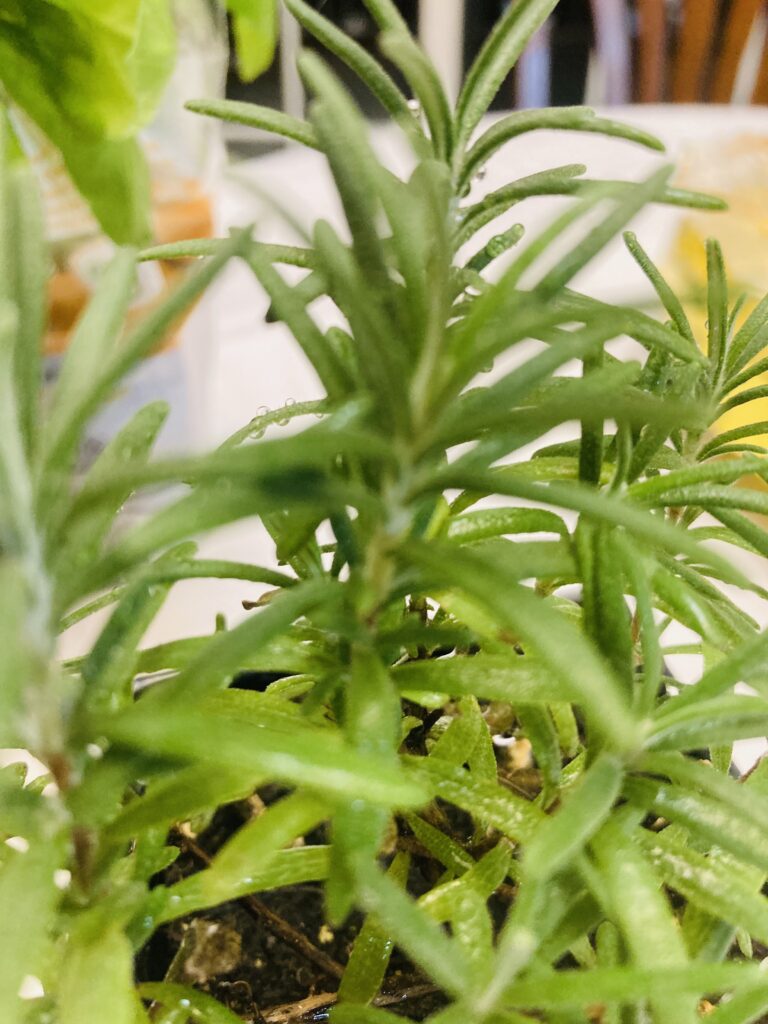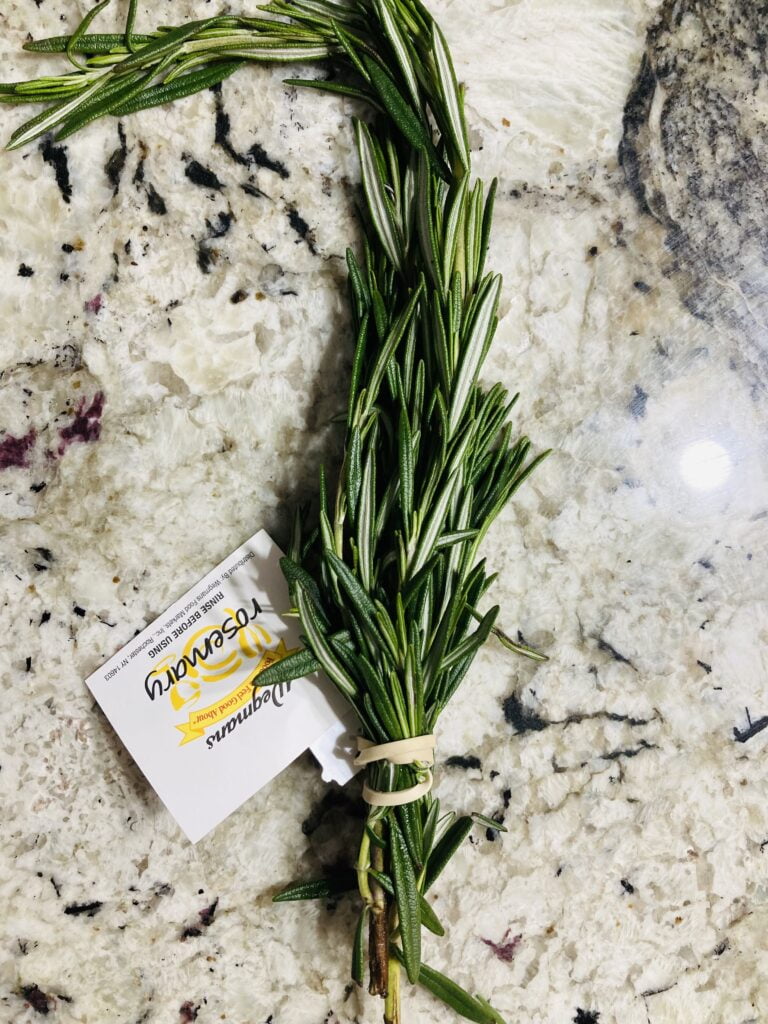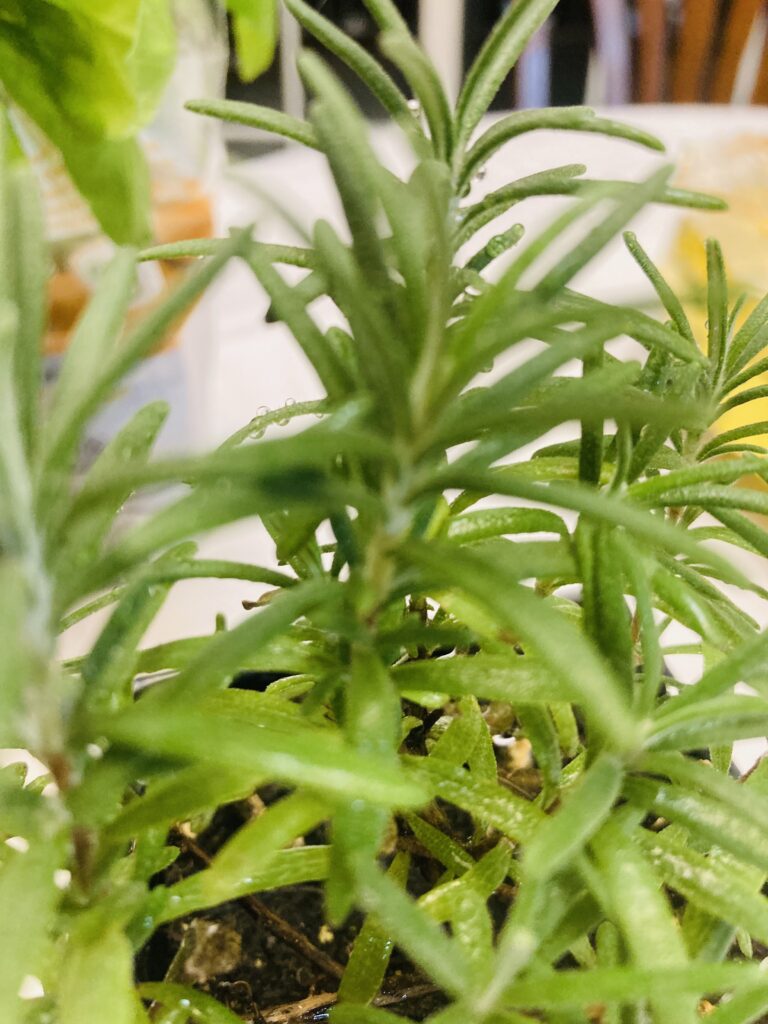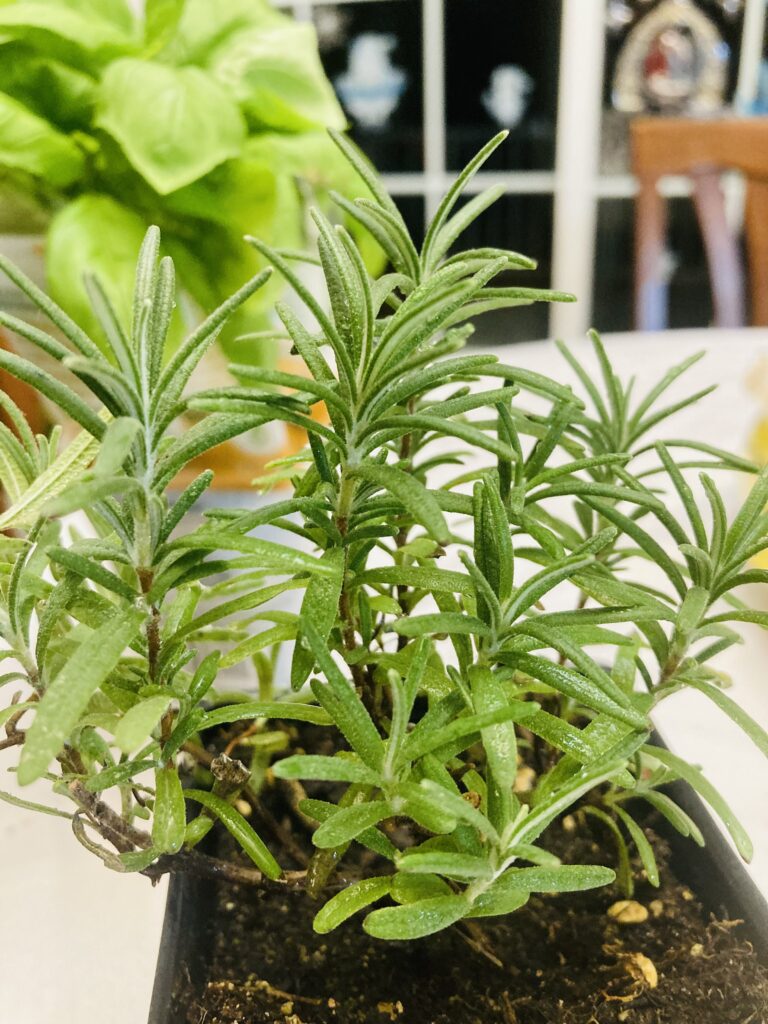Rosemary leaves are needle-like, dark green, and they grow on woody stems. Cilantro leaves are flat, delicate, and bright green. The stems are tender and not woody. Rosemary has a strong, woody, and slightly pine-like flavor. It is often described as earthy and aromatic, with a hint of lemon and pine. While on the other hand Cilantro, also known as coriander leaves, has a bright, citrusy, and slightly peppery flavor. Some people perceive cilantro as having a fresh and slightly soapy taste, which is due to genetic differences in taste perception.

Key Appearances of Rosemary vs Cilantro
Rosemary:
- Leaves: Rosemary leaves are narrow and needle-like, resembling the shape of pine needles. They are about 1 to 2 inches (2.5 to 5 cm) in length. The color of the leaves is a deep, dark green, and they have a slightly waxy texture and blossom white, pink, purple, or blue flowers.

- Stems: Rosemary plants have woody stems that can become quite thick as the plant matures. The stems are often brownish or grayish in color and become more rigid over time. They can be quite tough and woody, making them suitable for use as skewers or for adding flavor to roasted dishes.
Cilantro (Coriander):
- Leaves: Cilantro leaves are flat, delicate, and have a feathery appearance. They are often lobed with serrated edges, and they are bright green in color. The leaves are relatively tender and easy to chop. They have a distinct, fresh, citrusy aroma.
- Stems: Cilantro stems are thin, tender, and not woody. They are also green, similar in color to the leaves, and they are edible. While the leaves are the main focus for culinary use, the stems also carry some flavor and can be used in cooking.


Flavor of Rosemary vs Flavor Of Cilantro
Rosemary is a versatile herb known for its distinct flavor profile. It has a robust, woody taste with a slightly resinous quality, reminiscent of pine needles. This herb is often characterized as earthy and aromatic, which can add depth and complexity to various dishes.
The primary flavor notes of rosemary come from its essential oils, which contain compounds like pinene, cineole, and camphor. These compounds contribute to its distinctive taste and aroma. Additionally, rosemary has a subtle hint of lemon-like citrus, which adds a refreshing and bright element to its overall profile.
When used in cooking, rosemary can enhance a wide range of dishes, from savory to sweet. It pairs particularly well with meats like lamb, pork, and chicken, as well as with hearty vegetables like potatoes and carrots. The aromatic nature of rosemary also makes it a popular choice for infusing oils, marinades, and sauces.
Due to its potent flavor, it’s important to use rosemary sparingly, especially if using dried leaves, as they can be quite potent. Fresh rosemary leaves can be chopped, crushed, or used whole to impart their flavor to a dish. Keep in mind that the longer rosemary is cooked, the more its flavor will mellow and integrate into the overall taste of the dish.
Overall, rosemary’s combination of woody, pine-like, earthy, and citrusy notes makes it a beloved herb in many culinary traditions around the world. Its versatility and unique flavor profile make it a popular choice for chefs and home cooks alike.
Flavor Of Cilantro
Cilantro a herb commonly used in various cuisines around the world. It has a distinctive and polarizing flavor profile. Some people find cilantro to have a bright, citrusy, and slightly tangy taste, while others describe it as soapy or pungent.
The perception of cilantro’s flavor can vary significantly from person to person due to genetic differences in taste receptors. For some individuals, a genetic predisposition makes them more sensitive to certain chemical compounds found in cilantro, which can lead to a soapy or unpleasant taste perception.
It’s worth noting that cilantro is a key ingredient in many dishes, particularly in Mexican, Indian, Thai, and other Asian cuisines. Its flavor complements a wide range of savory dishes, salads, salsas, and sauces. If you enjoy cilantro, it can add a fresh and aromatic element to your cooking. If you’re one of the people who find it unappealing, you might want to explore alternative herbs or spices to use in your recipes.
Culinary uses of Rosemary and Cilantro
Rosemary and cilantro are both versatile herbs that can be used in a variety of culinary applications to add flavor and aroma to dishes. Here are some common uses for each.


Rosemary:
- Roast Meats and Vegetables: Rosemary is often used to flavor roasted meats like lamb, chicken, and pork. It pairs particularly well with potatoes and other root vegetables.
- Grilled Dishes: Sprigs of rosemary can be used as skewers or placed directly on the grill to infuse meats and vegetables with flavor.
- Soups and Stews: Add fresh or dried rosemary to soups and stews for a fragrant and earthy flavor.
- Breads and Baked Goods: Incorporate chopped fresh rosemary into bread dough or use it as a garnish on focaccia and other savory baked goods.
- Marinades and Rubs: Mix rosemary with other herbs, garlic, and olive oil to create marinades or rubs for meats and vegetables.
- Infused Oils and Vinegars: Make rosemary-infused olive oil or vinegar to use in dressings or for drizzling over dishes.
Cilantro:
- Salsas and Guacamole: Cilantro is a key ingredient in many salsas and guacamole recipes, adding a bright, fresh flavor.
- Soups and Curries: Add chopped cilantro to soups, stews, and curries for a burst of flavor and a pop of color.
- Salads: Toss fresh cilantro leaves into salads to add a zesty and aromatic element.
- Asian Dishes: Cilantro is commonly used in Asian cuisine, particularly in dishes like Thai salads, Vietnamese pho, and various Chinese stir-fries.
- Mexican and Tex-Mex Cuisine: It’s a staple herb in Mexican cuisine, used in dishes like tacos, enchiladas, and burritos.
- Garnish: Sprinkle chopped cilantro over finished dishes as a colorful and flavorful garnish.
- Marinades and Dressings: Blend cilantro with lime juice, garlic, and other ingredients to create marinades or salad dressings.
Remember that both herbs have strong flavors, so it’s important to use them in moderation to avoid overpowering your dishes. Additionally, while rosemary can withstand longer cooking times, cilantro is best used fresh as it tends to lose its flavor when exposed to prolonged heat.
Differences between Rosemary and Cilantro
| Rosemary | Cilantro |
|---|---|
| Botanical Classification: Family: Lamiaceae Scientific Name: Rosmarinus officinalis | Botanical Classification: Family: Apiaceae Scientific Name: Coriandrum sativum |
| Appearance: Leaves are needle-like, dark green, and grow on woody stems. Stems are tough and woody. | Appearance: Leaves are flat, delicate, and bright green. Stems are tender and not woody. |
| Flavor: Strong, aromatic, piney, and slightly earthy with a hint of citrus. | Flavor: Fresh, citrusy flavor with a slightly peppery undertone. |
| Aroma: Robust, earthy, and slightly piney | Aroma: Bright, citrusy aroma |
| Culinary Uses: Commonly used in Mediterranean cuisine. Pairs well with meats (especially lamb and poultry), potatoes, and various roasted dishes. Used in marinades and as a seasoning for soups and stew | Culinary Uses: Popular in various global cuisines including Mexican, Indian, Thai, and Middle Eastern. Used in salsas, guacamole, curries, salads, and various dishes for its fresh, zesty flavor. |
| Stem Texture: Tough and woody, suitable for use as skewers or for adding flavor to roasted dishes. | Stem Texture: Thin, tender, and not woody. Stems are green, similar in color to the leaves. |
| Growth Habit: Perennial herb that can grow into a small shrub or bush if left unpruned. Can be grown in gardens or as a potted plant. | Growth Habit: Annual herb that completes its life cycle in a single growing season. Tends to bolt quickly in warm weather, often grown as a cool-season herb. |
| Medicinal Properties: Believed to have antioxidant and anti-inflammatory properties | Medicinal Properties: Thought to aid digestion and may have antibacterial properties |
| Toxicity for Pets: Can be toxic to pets if ingested in large quantities | Toxicity for Pets: Generally safe for pets |
Health benefits of Rosemary
Rosemary and cilantro are both herbs that are commonly used in cooking and have a range of potential health benefits:

Rosemary:
- Rich in Antioxidants: Rosemary is high in antioxidants, which help protect the body’s cells from damage caused by free radicals.
- Anti-Inflammatory Properties: Some compounds in rosemary, such as rosmarinic acid and carnosic acid, have anti-inflammatory effects and may help reduce inflammation in the body.
- Improves Digestive Health: Rosemary has been traditionally used to aid digestion. It may help stimulate the production of digestive enzymes, which can improve nutrient absorption.
- Memory and Cognitive Function: There is some evidence to suggest that the aroma of rosemary may improve memory and cognitive function. However, more research is needed in this area.
- Antimicrobial Properties: Rosemary contains compounds that have been shown to have antimicrobial properties, which may help protect against certain types of bacteria.
- Pain Relief: Rosemary oil or extracts may be used topically for pain relief due to its analgesic properties.
Key herb in reducing Cortisol level during Aromtherapy.
Research has shown by inhaling the scent of rosemary has been associated with enhancing mood, sharpening mental clarity, alleviating stress, and reducing cortisol levels, particularly in individuals experiencing chronic anxiety or stress-related hormonal imbalances. The fragrance of rosemary has the remarkable ability to swiftly decrease cortisol levels, providing relief from stress. By easing the strain on the adrenal glands, the body can facilitate their restoration process.
8 Health benefits of Cilantro
Cilantro (Coriander):
- Rich in Nutrients: Cilantro is a good source of vitamins and minerals, including vitamin A, vitamin K, vitamin C, potassium, and folate.
- Antioxidant Properties: Cilantro contains antioxidants, such as quercetin, which can help neutralize harmful free radicals in the body.
- Digestive Health: Cilantro has been traditionally used to aid digestion and may help stimulate the production of digestive enzymes.
- Detoxification: Some studies suggest that cilantro may help remove heavy metals from the body, acting as a natural chelation agent.
- Anti-Inflammatory: Cilantro contains compounds like linalool and borneol that have anti-inflammatory properties, which may help reduce inflammation.
- May Lower Blood Sugar: Some animal studies have suggested that cilantro may help lower blood sugar levels, though more research is needed in humans.
- Brain Health
- Although further research is still needed, several studies have connected eating cilantro with reduced symptoms of cognitive diseases like Alzheimer’s and Parkinson’s disease.
- In one study, cilantro extract reduced seizure attacks and prevented nerve-cell damage in rats. In another, when fresh cilantro leaves were added to the diets of laboratory mice, scientists saw improvements in their memory.
- Reduce Anxiety Cilantro plant extracts have demonstrated significant potential in animal studies for alleviating anxiety symptoms, showing comparable efficacy to certain medications. However, further research involving human subjects is necessary to validate these findings.
It’s worth noting that while both herbs have potential health benefits, they should be used as part of a balanced diet and not relied upon as the sole source of any particular nutrient or health benefit. It’s always a good idea to consult with a healthcare professional or registered dietitian if you have specific health concerns or conditions.
Basic Tips for drying and Storing Rosemary
- Rosemary:
- Drying Method: To dry rosemary, you can use either an air-drying method or a dehydrator.
- Air-Drying: Tie bundles of rosemary stems together and hang them in a dry, well-ventilated area out of direct sunlight. This can take about 1-2 weeks.
- Dehydrator: Place rosemary sprigs on a dehydrator tray set at a low temperature (around 95°F or 35°C) until they are thoroughly dried. This process typically takes 1-4 hours.
- Storage: Once dried, remove the leaves from the stems and store them in an airtight container, away from direct light and moisture. Label the container with the date of drying. Properly stored dried rosemary can maintain its flavor for up to a year.
- Drying Method: To dry rosemary, you can use either an air-drying method or a dehydrator.
Advantages of rosemary over cilantro
1. Flavor Profile: Rosemary has a strong, aromatic, and slightly woody flavor with hints of pine. It pairs well with a variety of savory dishes, particularly those featuring poultry, lamb, and roasted vegetables. Cilantro, on the other hand, has a fresh, citrusy, and slightly peppery flavor. It is commonly used in Mexican, Indian, and Southeast Asian cuisines.
2. Versatility: Rosemary is a versatile herb that can be used in a wide range of dishes, from meats to stews, soups, and even bread. It’s especially popular in Mediterranean cuisine. Cilantro is more specialized and is commonly used in dishes like salsa, guacamole, curries, and various salads.
3. Heat Tolerance: Rosemary is a hardy herb that can withstand high heat and prolonged cooking times without losing its flavor. This makes it ideal for roasting, grilling, and braising. Cilantro, on the other hand, is more delicate and should be added towards the end of cooking to preserve its flavor.
4. Storage: Rosemary tends to have a longer shelf life compared to cilantro. It can be dried and stored for an extended period, allowing you to have it on hand even when fresh isn’t available. Cilantro, on the other hand, tends to wilt and lose its flavor relatively quickly.
5. Medicinal Properties: Rosemary has been traditionally used for its medicinal properties, which include being an antioxidant and having potential anti-inflammatory and antimicrobial effects. It’s also believed to support memory and concentration. Cilantro also has some health benefits, such as being a good source of vitamins and minerals, but it is not typically used for its medicinal properties to the same extent as rosemary.
6. Culinary Complements: Rosemary pairs well with a wide range of other herbs and ingredients, including thyme, garlic, lemon, and olive oil. Cilantro is often used alongside lime, garlic, chilies, and other ingredients common in Mexican, Thai, and Indian cuisine.
Ultimately, the choice between rosemary and cilantro will depend on the specific dish you’re preparing and the flavor profile you’re aiming for. They are both wonderful herbs, but they serve different culinary purposes.
Basic Important Tips on how to store Cilantro
- Cilantro:
- Fresh Usage: Cilantro is best used fresh, as its flavor is most vibrant in its natural state. It’s commonly added to dishes just before serving to preserve its aromatic qualities.
- Preservation Methods:
- Freezing: Wash and thoroughly dry cilantro leaves. Chop them finely and place them in ice cube trays, covering them with water or olive oil. Once frozen, transfer the cubes to a zip-top bag. This method retains more flavor than traditional drying.
- Pesto or Sauces: You can blend cilantro with garlic, olive oil, and other ingredients to make a pesto or sauce. These can be frozen in small portions and used later as a flavoring agent in various dishes.
- Note: When cilantro is dried, it tends to lose some of its distinctive flavor and aroma, so freezing or using in sauces can be a better option for preservation.
Remember that both herbs should be stored in airtight containers to prevent moisture and air exposure, which can lead to flavor loss. Additionally, labeling with the date of drying or preparation can help you keep track of their freshness.
Nutritional Values of Rosemary vs Cilantro
| Rosemary | Cilantro |
|---|---|
| Calories: 131 kcal Protein: 3.31 g Fat: 5.86 g Saturated Fat: 1.66 g Monounsaturated Fat: 2.97 g Polyunsaturated Fat: 0.60 g Carbohydrates: 20.70 g Dietary Fiber: 14.10 g Sugars: 0.90 g Vitamins and Minerals: Vitamin A: 2924 IU Vitamin C: 61.2 mg Vitamin K: 176 µg Calcium: 317 mg Iron: 6.65 mg Potassium: 955 mg | Calories: 23 kcal Protein: 2.13 g Fat: 0.52 g Saturated Fat: 0.04 g Monounsaturated Fat: 0.18 g Polyunsaturated Fat: 0.14 g Carbohydrates: 3.67 g Dietary Fiber: 2.8 g Sugars: 0.87 g Vitamins and Minerals: Vitamin A: 6748 IU Vitamin C: 27 mg Vitamin K: 310 µg Calcium: 67 mg Iron: 1.77 mg Potassium: 521 mg |
| Values are approximate | Values are approximate |
Cultivating Rosemary and Cilantro can be a rewarding experience, as both herbs have unique flavors and can be used in a variety of culinary dishes. Here are some general tips for growing Rosemary and Cilantro:
Cultivating Rosemary vs Cilantro
Rosemary:
- Sunlight: Rosemary thrives in full sun. It requires at least 6-8 hours of direct sunlight daily.
- Soil: Well-draining soil is crucial for Rosemary. It prefers slightly alkaline soil with a pH between 6.0 and 7.0.
- Watering: Rosemary is drought-tolerant once established. It’s important not to overwater, as it is susceptible to root rot. Allow the soil to dry out between watering’s.
- Container vs. Ground: Rosemary can be grown in containers or directly in the ground. If planting in a container, make sure it has good drainage.
- Pruning: Regular pruning helps maintain a bushy and healthy plant. Trim the tips of the branches to encourage growth.
- Fertilizing: Rosemary doesn’t require much fertilizer. If you do fertilize, use a balanced, all-purpose fertilizer sparingly.
- Pests and Diseases: Rosemary is relatively resistant to pests and diseases. However, it can sometimes be affected by powdery mildew or spider mites.
Cilantro (Coriander):
- Sunlight: Cilantro prefers partial shade, especially in hot climates. It can tolerate full sun in cooler regions.
- Soil: Well-draining soil with a pH between 6.2 and 6.8 is ideal for cilantro.
- Watering: Keep the soil consistently moist, but not waterlogged. Mulching around the base of the plant can help retain moisture.
- Container vs. Ground: Cilantro can be grown in containers, but it prefers being planted directly in the ground.
- Succession Planting: Cilantro has a tendency to bolt (produce flowers and seeds) quickly, especially in warm weather. To ensure a continuous harvest, plant new seeds every few weeks.
- Harvesting: Harvest leaves when they are young and tender. Once cilantro bolts, the leaves lose some of their flavor.
- Fertilizing: Cilantro doesn’t require heavy fertilization. A balanced, all-purpose fertilizer applied sparingly should be sufficient.
- Pests and Diseases: Cilantro can sometimes be susceptible to aphids, whiteflies, and powdery mildew. Regularly inspect your plants and take appropriate measures if you notice any issues.
Remember to monitor your plants regularly for signs of pests, diseases, or any other issues. Providing the right conditions and care will help ensure healthy and thriving Rosemary and Cilantro plants in your garden.
Resources
https://www.britannica.com/plant/rosemary
https://www.webmd.com/diet/health-benefits-cilantro
https://en.wikipedia.org/wiki/Coriander
https://en.wikipedia.org/wiki/Rosemary
https://www.ncbi.nlm.nih.gov/pmc/articles/PMC749149
https://koreascience.kr/article/JAKO201016450253350.page
Food Cures: Improve Your Health Through What You Eat. Publications International, Ltd., 2019.









